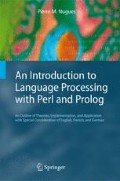Abstract
In the previous chapters, we used Prolog’s built-in search mechanism and the DCG notation to parse sentences and constituents. This search mechanism has drawbacks however. To name some of them: its depth-first strategy does not handle left-recursive rules well and backtracking is sometimes inefficient. In addition, if DCGs are appropriate to describe constituents, we haven’t seen means to parse dependencies until now.
Access this chapter
Tax calculation will be finalised at checkout
Purchases are for personal use only
Preview
Unable to display preview. Download preview PDF.
11.8 Further Reading
Aho, A. V., Sethi, R., and Ullman, J. D. (1986). Compilers: Principles, Techniques, and Tools. Addison-Wesley, Reading, Massachusetts.
Allen, J. F. (1994). Natural Language Understanding. Benjamin/Cummings, Redwood City, California, second edition.
Bikel, D. M. (2004). Intricacies of Collins’ parsing model. Computational Linguistics, 30(4):479–511.
Charniak, E. (1993). Statistical Language Learning. MIT Press, Cambridge, Massachusetts.
Charniak, E. (2000). A maximum-entropy-inspired parser. In Proceedings of the First Meeting of the North American Chapter of the ACL, pages 132–139, Seattle.
Collins, M. J. (1999). Head-Driven Statistical Models for Natural Language Parsing. PhD thesis, University of Pennsylvania.
Constant, P. (1991). Analyse syntaxique par couches. Thèse de doctorat, École Nationale Supérieure des Télécommunications, Paris.
Covington, M. (1990). Parsing discontinuous constituents in dependency grammar. Computational Linguistics, 16(4):234–236.
Covington, M. (1994). Natural Language Processing for Prolog Programmers. Prentice Hall, Upper Saddle River.
Frühwirth, T. (1998). Theory and practice of constraint handling rules. Journal of Logic Programming, 37(1–3):95–138.
Gal, A., Lapalme, G., and Saint-Dizier, P. (1989). Prolog pour l’analyse automatique du langage naturel. Eyrolles, Paris.
Gazdar, G. and Mellish, C. (1989). Natural Language Processing in Prolog: An Introduction to Computational Linguistics. Addison-Wesley, Wokingham.
El Guedj, P.-O. (1996). Analyse syntaxique par charts combinant règles de dépendance et règles syntagmatiques. PhD thesis, Université de Caen.
Hellwig, P. (1980). PLAIN — a program system for dependency analysis and for simulating natural language inference. In Bolc, L., editor, Representation and Processing of Natural Language, pages 271–376. Hanser, München.
Hellwig, P. (1986). Dependency unification grammar (DUG). In Proceedings of the 11th International Conference on Computational Linguistics (COLING 86), pages 195–198.
Hindle, D. and Rooth, M. (1993). Structural ambiguity and lexical relations. Computational Linguistics, 19(1):103–120.
Jurafsky, D. and Martin, J. H. (2000). Speech and Language Processing, An Introduction to Natural Language Processing, Computational Linguistics, and Speech Recognition. Prentice Hall, Upper Saddle River.
Manning, C. D. and Schütze, H. (1999). Foundations of Statistical Natural Language Processing. MIT Press, Cambridge, Massachusetts.
Pereira, F. C. N. and Shieber, S. M. (1987). Prolog and Natural-Language Analysis, volume 10 of CSLI Lecture Notes. Center for the Study of Language and Information, Stanford.
Tapanainen, P. and Järvinen, T. (1997). A non-projective dependency parser. In Proceedings of the Fifth Conference on Applied Natural Language Processing (ANLP’97), pages 64–71, Washington, D.C. ACL.
Vergne, J. (1998). Entre arbre de dépendance et ordre linéaire, les deux processus de transformation: linéarisation, puis reconstruction de l’arbre. Cahiers de grammaire, 23.
Zelle, J. M. and Mooney, R. J. (1997). An inductive logic programming method for corpus-based parser construction. Technical note, University of Texas at Austin. http://www.cs.utexas.edu/users/ml/publication/ilp.html. Cited 28 October 2005.
Rights and permissions
Copyright information
© 2006 Springer-Verlag Berlin Heidelberg
About this chapter
Cite this chapter
(2006). Parsing Techniques. In: An Introduction to Language Processing with Perl and Prolog. Cognitive Technologies. Springer, Berlin, Heidelberg. https://doi.org/10.1007/3-540-34336-9_11
Download citation
DOI: https://doi.org/10.1007/3-540-34336-9_11
Publisher Name: Springer, Berlin, Heidelberg
Print ISBN: 978-3-540-25031-9
Online ISBN: 978-3-540-34336-3
eBook Packages: Computer ScienceComputer Science (R0)

